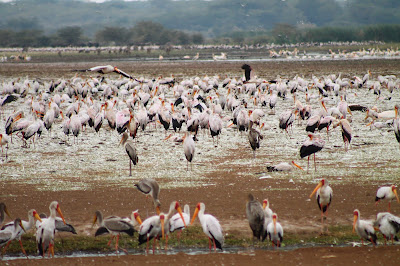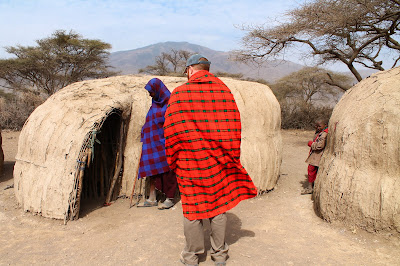Without a doubt, the most troubling experience of the trip was the day we visited a Maasai village. I didn't really know anything about these tribes until our driver - who is part Maasai - told us about them and pointed them out as we drove around the country.
There are a bazillion different types of tribes that drive cattle across the land; they all speak different languages and may or may not be able to communicate with each other. Considering that they are
literally in the middle of nowhere, with such few natural resources at their disposal, this boggles the mind.
On the day of our longest drive between parks, what's known as a transit day, Nas suggested that if we wanted to break up the drive, he could take us to tour a Maasai village. I jumped at the chance. He told us that this is a service many safari companies offer as a way to help these nomadic people. For a donation of $50, tourists could take a tour (led by a villager or guide who speaks English). The money helps the villagers pay for doctors or supplies or whatever.
I was all about it.
And then we got there.
It's hard to describe just how in-the-middle-of-nowhere these people live. Imagine driving through a white desert wasteland for about 3 hours without any towns, any stores, any other cars on the (dirt) road. There are no other people. There isn't even grass; honestly I have no idea what the cattle eat.
Our tour went like this.
When our jeep drove up, the men ran to greet us. It was so windy and dusty that as soon as we hopped out of the jeep, a couple of them took off their blankets and wrapped them around us, showing us how to shield our faces. Then they took us to the village where the men danced and sang for us.
The men were very much the focal point. The women, I noticed, huddled against the huts and kept the curious children out from under foot. While the men were putting on a show, the women seemed much more interested in chatting among themselves for a bit, chiming in with shouts and hums every now and then.
About one minute into the welcome song, things began to feel weird and just...wrong. Our guide was a young man, probably a few years out of college, who was Maasai and spoke broken English. About every three seconds, he would point to the camera around my neck and say, "You can take picture! They sing for you! You can take photo!" We kept explaining that no, no, it's OK, and we'll take a photo when we want to, but honestly I think he thought we didn't understand the process. I think he thought that we had paid them this money and now they were performing for us and we didn't have the good sense to take pictures of it all.
Which made the experience feel performative and manufactured, as if the white people came for a show and the savages were playing along.
The next thing they did was show us how they make fire. Considering the crazy wind (which really doesn't show well in the pictures) it was pretty darn amazing.
I wandered away to take a picture of this curious lil guy and our guide
took me by the shoulders and led me back to the fire show, pointing explicitly at the men, as if I didn't realize I should be photographing them instead of the baby. He wasn't rude about it. Honestly, I think he was trying to be helpful in herding the white folks about.
Next, we took a tour of a house. I took this picture with G in the foreground for scale.
The Maasai are nomadic: they follow their herds of cattle and when the cattle move on to more fertile pastures, so do they. The men collect supplies for the huts and bring them to the women who build them. They are made of sticks covered in a mud-like mixture of cow dung and water. Each hut has a kitchen (where we are sitting above) and right behind the camera is the bedroom: a mat of cow hide with a sheet up as a wall in the middle of it. One side is for the children and the other is for the parents. The huts make up the circular wall of the village.

Inside the circle of huts is the "market" where they keep their goods for sale (made by the women) and also their domesticated animals (goats and chickens) that are not herded about with the cattle. At this point in the tour, we were encouraged to shop. I was huddled in that blanket, walking around the big circle, and every time I would stop to look at or touch something, the guide would encourage me to buy it, cooing about how beautiful and lovely it was.
I picked a few things and then the haggling began. I don't like haggling and neither does G, so when the guide picked a number, I was like (shaking my head) "No." Then he would lower it and I was like, "No." That's how the introverts do it. When we settled on a price he would not let us proceed with the tour until we took an official picture of the purchase. I swear I think he thought this tour was a failure because we weren't snap snap snapping away the whole time.
As I took this I said, "Everyone say Maasai patriarchy!" G was not amused. But I was.
With that awkwardness out of the way, the last stop of the tour was the school house, which was located just outside the village.
As we walked toward it, we could hear the kids screaming in anticipation. When we walked in, they belted out some tune in Swahili. It was pure cacophony.
Then children took turns leading the class through a series of English exercises such as reciting the alphabet and counting to twenty. Despite the fact that these people are completely isolated from the world, they do go to school and they are bilingual; all school children learn both Swahili and English (but the tribes also speak their own languages, which differ quite a bit).
All of the children in this school house were the Chief's. The women in that first picture? They are all the wives of the chief. The men who danced for us are either grown sons or helpers who, at the end of the day, will go off on their own to other villages.
Out of all the chief's sons, one or perhaps two will go to high school and university, with the expectation that they will return to the village afterwards.
From start to finish, including my awkward shopping trip, the whole experience was maybe 45 minutes. But after the school tour I was basically high stepping it to the jeep.
As much as I am intrigued by these tribespeople, I couldn't wait to get out of there because my presence felt wrong and intrusive. In retrospect, I don't think it was. Nas explained to us that the Tanzanian government encourages tourists to visit these villages because of the money they bring in which helps the tribes purchase much-needed supplies from the government. On its own a tribe does not have any money. The only resources it has are from the land, and I gotta tell you, it looks like those are few and far between.
Our guide explained to us that the Maasai eat the cattle. They drink blood and milk from the cattle. There are no plants. No fruits or vegetables to pick. In the dry season (when we visited) there are hardly any creeks or rivers, and the water they do come across must be used for the cows. That's it. That's their diet.
At some point the next day on safari it hit me:
The Maasai don't even have coffee, because they don't have access to water.
I ask you.
The villagers did not seem out of sorts or uncomfortable or put upon at all by our presence. They performed, and that part was perfunctory and bizarre and odd to us - not so much to them - but then they went about their business. Other than the children, no one eyed us or seemed to think we were out of place at all. The children, though. Is this their lens into the outside world, these (mostly pale) strangers who wander into their village and then back out again? Does that become a part of their reality, the world coming to them instead of them going out in the world?
But then how much more out in the world can one get than living on the land as a nomad? Wandering from place to place
forever, each day almost a mirror image of the one before.
I'm conflicted because I don't want to be someone who (literally) walks into someone else's community and treats them like a photographic subject. And yet, if I didn't have that exposure, I wouldn't know anything about them at all. And, furthermore, I wouldn't be able to share their experience with anyone else (I mean, did
you know anything about them?). But, it's odd, this disparity in our realities. To me, the Maasai are like a part of my Tanzanian adventure. To them, I'm...what? A money-giver? A person who must be prodded to do my part in our unspoken contract and take pictures while they dance and sing?
I don't have clarity on this experience and I think that's OK. I think that's God working on me a bit.
But no coffee? I mean, come on.























































